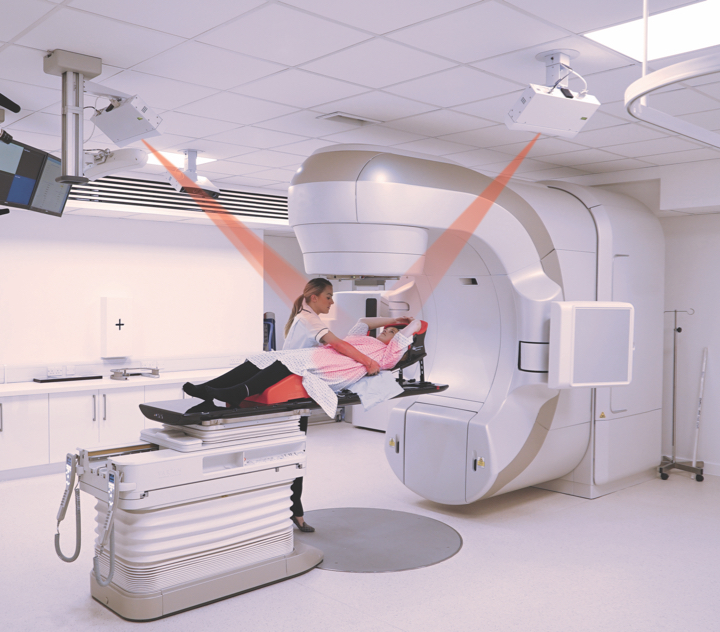
Radiation Therapy
Approximately 50% of cancer patients receive some type of radiation therapy during their cancer treatment.
Radiation can be used on its own or in combination with chemotherapy, surgery, or hormone therapy.
It is used to destroy cancer cells and is completely painless and is usually given once a day for between 1 day and 8 weeks.
General Radiation Therapy Information
Radiation Therapy (also called Radiotherapy)
Radiation therapy is an important part of treatment for around half of all cancer patients.
What is radiation therapy?
Radiation therapy is the use of high-energy x-rays or other particles to kill cancer cells.
Radiation treatments are completely painless, similar to getting a chest x-ray.
How does it work?
Normal cells grow and divide to form new cells. Cancer cells grow and divide faster than most normal cells. Radiation works by making small breaks in the DNA inside cells as they are dividing. This makes cancer cells a lot more vulnerable to radiation than normal cells, as they divide more often. These breaks in the DNA keep cancer cells from growing and dividing, causing them to die.
The goal of radiation therapy is to destroy cancer cells and / or slow tumor growth without harming nearby healthy tissue.
Who gets radiation therapy?
Approximately 50% of cancer patients receive some type of radiation therapy during their cancer treatment. Radiation therapy can be used on its own, or in combination with chemotherapy, surgery, or hormone therapy.
Types of radiation
The most common type of radiation is called external-beam radiation therapy, which is given from a machine located outside the body. Types of external-beam radiation therapy include proton therapy, 3-dimensional conformal radiation therapy (3D-CRT), intensity-modulated radiation therapy (IMRT), and stereotactic radiation therapy (SRS or SBRT). Radiation can also be given using implants – this is called internal radiation therapy or brachytherapy.
When is radiation used?
Radiation can be used by itself to make the cancer shrink or completely go away. In some cases, chemotherapy may be given first. For other cancers, radiation may be used before surgery to shrink the tumor or after surgery to help keep cancer from coming back.
How many times can I have radiation therapy?
There is a limit to the amount of radiation an area of your body can safely receive over the course of your lifetime. Depending on how much radiation an area has already been treated with, you may not be able to have radiation therapy to that area a second time. But, if one area of the body has already received the safe lifetime dose of radiation, another area might still be treated if the distance between the two areas is large enough.
Who gives radiation therapy treatments?
Radiation oncologist: This doctor is specially trained to treat cancer with radiation. This person oversees your radiation treatment plan.
Dosimetrist: This person plans where the radiation beams go to ensure that the most effective and safe dose of radiation.
Radiation therapist or radiation therapy technologist: This person operates the radiation equipment and positions you for each treatment.
Radiation physicist: This is a person who makes sure the radiation equipment is working as it should and that it gives you the exact dose prescribed by your radiation oncologist.
Radiation therapy nurse: This nurse has special training in cancer treatment and can give you information about radiation and managing side effects.
Before treatment
If you need radiation therapy, your first radiation therapy session is called a simulation and does not involve actual treatment. During this visit, your radiation team will position your body and then take a scan with a CT-scanner. At this time a technique may be used to note your position, such as permanent tattoos or temporary skin marks. These marks or technology are used to help the radiation team set up you up correctly for every treatment. Your treatment will begin a few days after simulation.
Treatment
Treatment is usually given once a day for between 1 day and 8 weeks. It typically takes five 30-minutes sessions (or a “fraction” as the doctor may call it). It is important that you try to stay in exactly the same position as during your simulation. Many clinics now use AlignRT® to assist them in ensuring you are in the right position.
What is hypofractionation?
Hypofractionation is an advanced treatment technique that is becoming a standard of care for lung, breast, and prostate cancer patients.
Using hypofractionation, or hypofractionated radiation therapy, higher doses of radiation are delivered over a shorter timeframe, so patients can complete their course of radiation therapy much faster than conventional treatments.
Some patients are eligible for extreme hypofractionation or SBRT (stereotactic body radiation therapy), which, when appropriate, can shave weeks off the traditional treatment length.
Because each cancer type requires a different approach, each patient’s treatment plan is customized to their unique needs and treatment goals.
Frequently Asked Questions About Radiation TherapyRadiation Side Effects
The side effects of radiation therapy vary and depend on the type and location of cancer, treatment dose, and your overall health. Side effects may include fatigue, skin reactions, upset stomach, and loose bowel movements. These often begin during the second or third week of treatment and may last for several weeks after the final radiation. Most side effects go away after treatment, although some long-term side effects may occur months after or years after treatment. Be sure to discuss the potential side effects with your doctors.
More Side Effect InformationHelpful Discussion Guides
A guide for conversations with your healthcare professional
For most patients, everything about radiation therapy is new. This downloadable card provides some key information and questions to ask your healthcare professional, to help you receive the best possible treatment and care.

Questions
Radiation therapy FAQs
Radiation Therapy
Other AlignRT treatable areas
Resources
Doctor discussion guides
